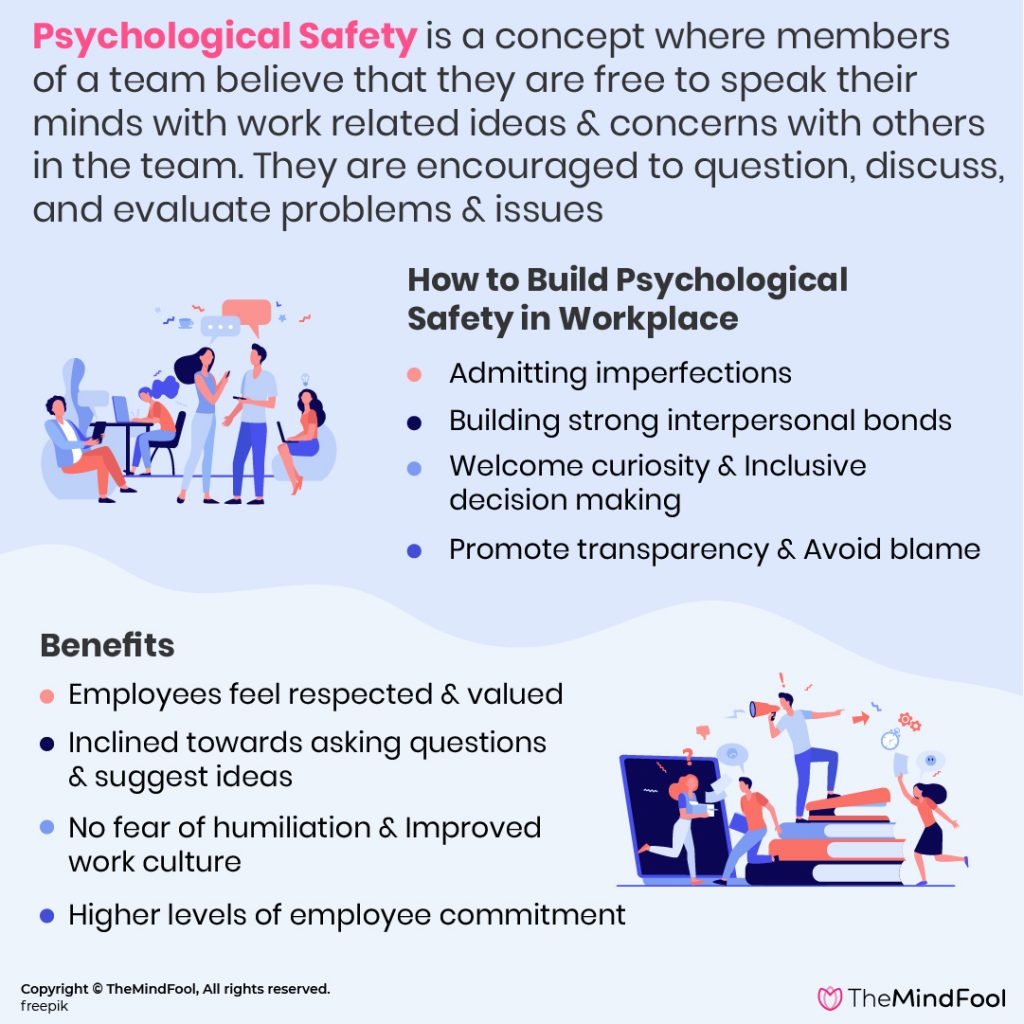
Have you ever felt a strong urge to voice your opinion amidst a team meeting but kept quiet; only because you had fears of being misjudged or evaluated? Do you feel that in most of the corporate workplaces, people do not open up and share their views too often?
There is a general tendency to maintain an image of being perfect, even if many wrong decisions are taken on a team’s behalf. All this happens because psychological safety was not in place.
It means that team members were hesitant, anxious and felt threatened to share their opinions or raise concerns with others. Why?
This may be because of fear, humiliation, and blame. There can be criticism, embarrassment, and lack of positive feedback from leaders or teammates. It can destroy the self-worth of the team members.
Psychological Safety Definition
SUMMARY
Psychological safety is a concept where members of a team believe that they are free to speak their minds with work-related ideas and concerns with others in the team. They are encouraged to question, discuss, and evaluate problems and issues. Fear of negative consequences is not present here.
The term psychological safety was first used by organizational behavior scientist from Harvard Business School, Amy Edmondson in 1999. Her research paper titled “psychological safety and learning behavior in work teams” highlighted this concept more vividly.
In her words, “It is a shared belief held by members of a team that the team is safe for interpersonal risk taking. It describes a team climate characterized by interpersonal trust and mutual respect in which people are comfortable being themselves”.
Psychological safety is all about creating guarded and prudent work setups where people feel comfortable. The members are free to interact, discuss, facilitate, and share ideas without fear of negative consequences such as harming self-image, status in terms of job position, and emotional embarrassment.
The workplace is a safe environment and is free from negative criticisms and evaluations. There is no place for eroding the self-esteem of one another. There is mutual respect, openness to ideas, admitting the team mistakes unhesitant.
Goals of Psychological Safety
The purpose of psychological safety is to nurture healthy minds within a work team. It enables the team to work coherently. The goal of this company culture is to foster positive attitude and employee engagement in teams working towards a common outcome.
Psychological safety is an important discussion in today’s structured corporate setups and global businesses. The main purpose is to create an environment where teams are proactive, fearless, and engaging.
They accept challenges and are always open to feedback from each other. Open communication, sharing of ideas, admitting individual or team mistakes openly brings overall growth of the organization.
The concept is a part of leadership and participatory management that builds cohesive and inclusive teams.
The following points help you to know the goals of psychological safety in a better way.
- To promote a healthy work culture in terms of motivation, employee participation, and strengthening action plans.
- The team members are encouraged to take interpersonal risks by sharing ideas, without any fear or insecurity.
- Teams would work with clearly defined objectives and executing plans together.
- Psychological safety helps to build dependable teams, where high-quality work gets done on time.
- Members will feel valued and appreciated for their individual inputs in the group.
- It enables curiosity to flourish. There is a speak-up culture that pervades within the team.

Why Do We Need Psychological Safety?
Effective and growth oriented work teams look safe, secure and possess some exceptional qualities that stand apart from others. So, a pertinent question that comes to our mind is what is the need of psychological safety?
Being able to work without fear improves your quality of work. When you find teams where people can voice opinions without fear of humiliation, you know the team is psychologically safe for risk taking.
Google conducted a pilot research called ‘Project Aristotle’ where it found that high performing teams within Google were reliable, trustworthy, and competent. Moreover in these teams, employees feel psychologically safe. They were capable enough to directly influence the sales and revenue figures of the organization.
This shows that psychologically safe team members were open to learning. They could adopt themselves well to new technologies and customer requirements.
To understand the need for psychological safety, let us take a close look at the following points.
1. Comfortable place to grow and thrive

We need safe and comfortable spaces to nurture individual potentials. Psychological safety helps teammates to feel confident with themselves and others.
No one in the team needs to hide their vulnerabilities and imperfections. There is an atmosphere of mutual trust, respect, good work ethics, and interest in each others’ opinions.
The members of the team do not attack each other’s competence, skills, motivation, and character. When teams feel safe, work culture develops because members are comfortable asking questions, seeks feedback quite openly.
2. Collaborative work culture

Psychological safety is needed to develop collective and shared learning. Everyone’s inputs are to be encouraged and appreciated. Information sharing, handling of mistakes are not constrained by differences in hierarchical position, power inequalities, or seniority.
In such teams, everyday problems are worked together after receiving feedback from all. There is no blame game on the team. Team members are accountable for their mistakes. Accusing, blaming, and scapegoating individual members are not present in safe teams.
3. Psychologically safe teams are proactive

You will always find that these safe teams are proactive. Each and every teammates show interest to identify mistakes and near misses to improve their work. Feedback and seeking help from colleagues enables continuous innovation and growth. Team members discuss issues candidly. There is transparency within the team.
4. Challenges the protocol

Psychological safety helps to challenge the protocol and business status quo. It enables members to freely discuss issues and problems. Thus, breakthrough business and innovative problem solving is made possible.
5. Diversity in the workplace

Team psychological safety is needed to foster diversity in the workplace. Personal risk taking is to be encouraged to generate new ideas and creativity within the group. The group members are encouraged to speak their mind and understand each other’s point of view. When members are confident, teams flourish with new and innovative ideas and soar high towards optimal growth.
Psychological Safety at Work
Research evidence claims that high performing teams have one thing in common and that is – psychological safety. This is a process of emotional wellness among team members to nurture trust, mutual respect, co-dependence, and skill building.
Moreover, a psychologically safe workplace looks and feels differently. They are open to take business risks and can easily challenge the decision making process of the other team members. As it is a critical credo of a joint workplace, without it, process innovation and prospective growth is not possible.
Psychological safety in the workplace ensures motivation, risk-taking, and exercising creativity. The organizations that are psychologically safe can retain good talent. There is also a higher revenue generation per employee.
Do you feel psychologically safe at the workplace?
If you feel reluctant or hesitant to voice your thoughts too often, you need to know that there is some emotional component lacking in your daily job. There may be times when you know that the team decisions being taken are not full proof, but you preferred to keep quiet. Why?
You were afraid to speak up because of the fear of being ridiculed or bullied. Finding you defensive in such situations are common. You do not share honest feedback because of the fear of finger pointing by others.
If these things are happening to you or any of your team members, then be sure that the atmosphere is not psychologically safe.
12 signs of low psychological safety at work
It is important for you to know how an insecure place would look like:
- Employees do not ask questions or raise issues in team meetings.
- You kept quiet because you never wanted to be judged by others.
- Teammates try to look perfect and obedient in front of the managers.
- Neither you nor your team members admit mistakes
- Playing blame games with each other in the team is common.
- You people never engage in heated discussions and arguments.
- There is no help-seeking from each other.
- No disagreements and differing opinions.
- Lack of mutual co-dependence and trust among members.
- Your manager never tried to inculcate team participation.
- Group meetings are monotonous as none of you shared new ideas and insight into it.
- You always perceive a potential psychological threat to your mental wellbeing. It may feel a tarnished self-image for you.
After you know the signs of low psychological safety, it’s time to know the characteristics of healthy and nurturing work setups.
The key features of psychologically safe workplace
- Team members develop a positive mindset towards growth and mutual evolution for the betterment of all.
- Psychological safety at work brings an open-minded attitude, divergent thinking, problem-solving, and creativity.
- Teams become curious, confident, and emotionally intelligent to solve problems and accomplish goals.
- Psychologically safe spaces are non-threatening, yet challenging where members feel confident to speak how they think and feel about various issues in the team.
- An attitude to ‘grow together’ comes from safe workplaces.
- Psychological safety acts as a protective shield against negative consequences such as being misunderstood by teammates.
- Employees focus on learning, innovation, experimentation, creativity, and excellence.
- The work environments are set in such a way that members are expected and enabled to share ideas and thoughts with others in the team.
- When you know that you are free to raise issues and ask questions for the benefit of the team, you start performing at an optimum level.
- Healthy interpersonal relations, team building, and mutual trust are possible in psychologically safe workspaces.
Leadership and Psychological Safety
Are you a leader pondering on ideas to improve team talent, engagement, and participation?
Do you believe that secure workplaces have become a necessity to flourish and thrive in a competitive business?
Is your team doing enough to share ideas, admitting mistakes and showcasing vulnerabilities?
If your answer is ‘no’, then you need to question your leadership style and work on it to fetch desired results.
You need to understand the loose ends within team interactions and the emotional constraints of its members. As we all know, leaders are the driving force behind high performing and agile teams.
The task is not as tough as it sounds. You just need to set the stage to foster emotional wellness in your team by creating psychological safety.
8 Tips for leaders to promote psychological safety
- You need to accept team members as they are; with their insecurities and fears.
- Support members by appreciating their opinions and small efforts. This makes them feel accepted in the group.
- You can open avenues for deeper discussions on matters of concern.
- Focus on making inclusive teams by bringing diversity in management.
- Try to tap into each and every member of the team for ideas, suggestions, and insights.
- Being a leader, you should try to develop group unity; creating an environment of mutual respect and friendship.
- You should promote a ‘speak-up’ culture within the team.
- Make a bully free team, where members feel safe from emotional hurt and humiliation.
12 Ways To Create Psychological Safety at The Workplace
Research shows that lack of interaction and mutual engagement at work is not an individual problem. The work culture supports disengagement and it pervades across teams in the organization.
So, the best way to fix this problem is by building a psychologically safe workplace. It is a place where members feel secure to verbalize their thoughts and feelings with more radical candor.
If you feel that your opinion counts; you feel inclined towards betterment. When you feel safe, you perceive the situation comfortable to take risks and pursue experimentation. It is the only secret to high performing teams.
To create psychologically safe teams is the building block of setting a trusted and respectful work culture.
Organizations are taking enough care these days to build such spaces involving the best industry practices.
1. Admitting imperfections within the team

Amy Edmondson recommended that the first person to start with is the leader of the team. She said that the senior executives should set the safe stage; and others are to follow them.
If you are a leader, start recognizing your flaws and imperfections. When you say that you are not perfect, and lacking somewhere; your team members will feel free to raise issues and share new workable ideas with you. You should create an atmosphere of mutual interaction and invite people to share their views.
Create candid conversations to grow together. Being a leader, you should invite feedback from the team and encourage them to speak up.
2. Building strong interpersonal relationships

Everyone has a belongingness need. We all want acceptance in a social group. A workplace team is also a social group. Strong interpersonal bonds and open communication without fear and hesitation should be developed.
You should trust and respect all individual members. As a leader, you should make your team members feel connected, safe, and accepted. Sharing ideas and encouraging members to accept the views of one another is a good way to induce psychological safety.
3. Encourage team participation

You need to design teamwork and activities in such a manner that team members feel motivated to participate in it. You should focus on individual quiet voices within the team.
Few members in the team may prefer to remain silent; so being a leader, invite them personally to share their thoughts with all in the team.
Each member should be allowed to speak. Be mindful of what members feel about others in the team. Open-ended questions and sharing of views to be encouraged for overall team participation.
4. Promote transparency

Being a leader of the team, try to create a space where the culture of discussions can thrive. You need to create a space where people feel transparent to talk about controversial issues.
Encourage friction and open communication within members. Call for more candid discussions, so that colleagues can help each other grow and learn from meaningful conflicts. Appreciate feedback given to each other. Promote transparent work ethics to foster support and trust amongst the teammates.
5. Set a tone for the involved team

It is your responsibility to assure the team members that they can let it all out from their minds. There is no need to hide issues and walk away. When you say so, team members become confident of their insecurities.
They feel happy that their voice will be heard. In this way, a culture is set where people feel free to talk about anxious and emotional issues.
Psychological safety is needed to ensure that silent problems are brought on the table without hesitation. Solutions are discussed within the team and the bond of the team members is strengthened.
6. Welcome curious minds

If you are a great team manager, appreciate curiosity and invite people to show their creative side. Curiosity enhances learning. It helps one to adapt to the changing situations. If team members show curiosity, it means they are open to learning and inquiry.
7. Extends trust within the team

Leaders should show trust in team members. In doing so, you help them develop a positive and growth mindset. Members feel respected and accepted. They also realize that their voice will get recognition. Making them feel comfortable to speak up and share ideas are going to promote team performance. The rule for the leader is ‘Build trust, keep trust’ going always in the team.
8. Show teammates that you’re engaged

A leader sets things through examples. So it is for you to ensure active participation in the team meetings. If your team members find that you are not interested to know or listen to their ideas and views, they’ll shut their mouths. Thus, you need to show engagement and be present in team meets.
Make eye contacts; keep your phone silent while the meeting is going on. Listen to what others have to say by actively participating in it. Make the best practice of ‘speak-up’ culture. Assure team members that it is always okay to share ideas and raise concerns. In this way, members feel accepted and approved.
9. Avoid blame and ridicule

Building psychological safety at the workplace requires patience and skill. Avoid blaming and ridiculing any one individual member of the team for any mistakes committed. You should focus on solutions and not problems. Tell all the members to find a better solution by working together. Focus on a collaborative tone of engaging teams; so that it appears a team fault. Never single out members for the mistakes done within the team.
10. Avoid negative team talks

Avoid having negative comments about peers and teammates within the team or elsewhere. Being an able leader, nip negative team talks as soon as you find it happening. Do not allow bad talks to flourish in the team. This helps to create an atmosphere of mutual trust and solidarity.
11. Inclusive decision making

While making decisions, involve your team. Ask for their inputs and suggestions. The team members should feel valued and accepted. Once a decision is made, hold a team meet, and explain how their feedback helped in the decision making process. Appreciate honest suggestions and feedback to deliver trust within the team. You should celebrate employee contribution and recognize the small part they played in the process.
12. Speak high about your team

It is essential to support and represent team efforts in front of all. Talk to your senior managers about your team’s contribution. Share their work with other evolving teams. In this way, you let your team know that you are with them.
Being a leader, appreciate all team efforts, and give due credit to the team members. When team members know that you support them, they work harder to accomplish goals together. This increases psychological safety and builds cohesive teams.
Psychological Safety and Teamwork
Creating a safe space promotes positive work culture within teams. Teamwork gets improved when members feel safe and know they will be heard and acknowledged. In this way, new ideas get generated. Teamwork becomes a collaborative process where members contribute separately but work cohesively.
Members know they will not be punished for speaking up, raising concerns and admitting mistakes. Teams feel motivated and accepted so they work hard to achieve excellence.
They perform well as they thrive in a culture of trust and openness. Ambitious goals can be easily achieved by this.
High performing teams work together. They commit mistakes and find innovative solutions. When psychological safety operates, team performance improves as there are multiple ways for employees to share their thoughts and get themselves heard by all.
Benefits of Psychological Safety
When employees know and feel that it is okay to make mistakes and own it, the atmosphere is considered safe to be in. The benefits of psychological safety are enormous for both teams and organizations.
Team and employee benefits
- Employees feel respected, valued, and accepted in the team
- Gets more inclined towards asking questions, suggesting ideas, and raises issues.
- No fear of humiliation or punishment.
- Team members know that their opinions matter during group discussions.
- Emotionally dependent social interactions develop through risk-taking.
- Healthy conflicts can arise through team engagement.
- Improved communication, sharing of knowledge can easily happen in safe places.
Organizational benefits
- Improved work culture with greater motivation
- Increased levels of commitment to work completion.
- The company’s revenue figures can increase with new innovations and producing developed products and services.
- Psychological safety helps to build inclusive teams.
- It helps organizations to know the skills of their employees.
- Emotionally aware and connected teams can be developed through psychological safety.
The link given below highlights ways of building psychological safety at workplace
Parting Words
Psychological safety is a prerequisite for a healthy and flourishing workplace culture. Such a set up facilitates employee engagement by connecting with people. It’s all about inspiring and empowering lives.
A Psychologist with a master's degree in Psychology, a former school psychologist, and a teacher by profession Chandrani loves to live life simply and happily. She is an avid reader and a keen observer. Writing has always been a passion for her, since her school days. It helps to de-stress and keeps her mentally agile. Pursuing a career in writing was a chance occurrence when she started to pen down her thoughts and experiences for a few childcare and parenting websites. Her lovable niche includes mental health, parenting, childcare, and self-improvement. She is here to share her thoughts and experiences and enrich the lives of few if not many.
